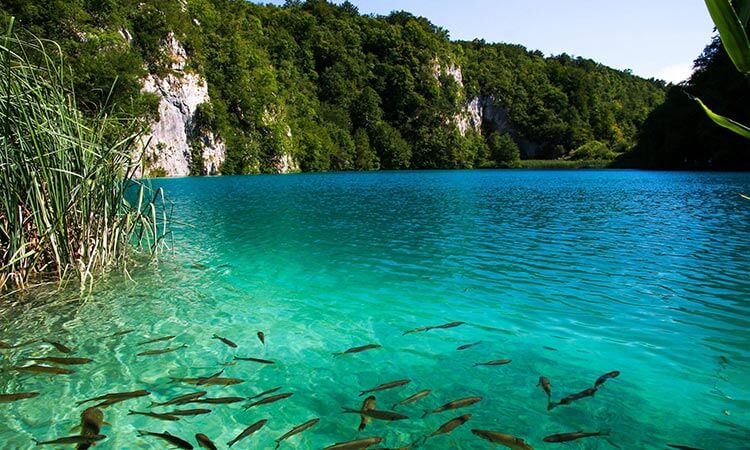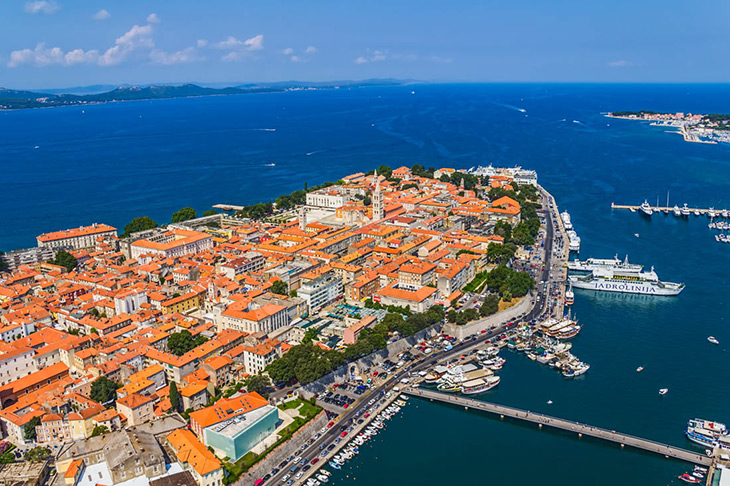Plitvice Croatia – Places To Visit On Plitvice Lakes
Published: December 22nd, 2019
Author: Mate I
Croatia – one of the most beautiful countries on Earth and home to countless natural tourist spots. If you’re a nature lover, visiting Croatia should definitely on your bucket list.
One of the most amazing of these spots is Plitvice Lakes.
Picture placid blue waters surrounded by trees that are majestically green in the spring and summer and then turn into a mesmerizing crisp yellow and orange canopy in the fall.
No matter what time of the year you go, this place will leave you breathless.

Imagine walking along the wooden and stone trails, the sound of flowing water from the numerous waterfalls surrounding the lakes in the background as birds sing joyously to each other on a bright, pleasant day. Explore the beauty of nature and let it clear your mind if only for a few moments.
Plitvice Lakes National Park is one of the oldest national parks in the country and still one of the biggest to this day.
It’s located in heart of the mountainous karsts of Central Croatia. Over a million tourists visit the park each year and naturally, most of them come back to experience it all over again.
Page Content:
What’s So Special About Plitvice Lakes?
You may think they’re just lakes and you can see lakes in some other places, too.
But the park’s collection of 16 natural lakes are incredibly breathtaking because of their turquoise waters and the views from below that it’s considered to be a UNESCO heritage site.

The park is in the middle of the country, about a hundred and thirty kilometers from the capital, Zagreb.
It’s heavily forested and the crystalline lakes tumble into each other through a series of cascading waters.
The waters from the lakes are rich in minerals and they carve through the surrounding rocks, constantly creating formations.
You will see clouds of butterflies fluttering above the wooden bridges and stone paths that cut through the rumbling waters.
What’s unique about the park compared to the rest of the world is that the lakes are arranged in cascades.
You can see all 16 lakes from the surface.
They were formed because of the convergence of other small rivers and they are all interconnected, following the main water flow.
What separates them are the natural dams of travertine, a form of limestone deposit from mineral springs. These travertine barriers grow about 1 centimeter each year.
Overall, the lakes cover about a 2-square kilometer area with water flowing out through the lowest lake that forms the Korana River.
The lakes are famous for their unique colors, in an array of deep azure hues to green, greys, and blues.

Wildlife of Plitvice Croatia
The lakes’ colors change as the amount of minerals or organisms in the water change. You will also see them transform as the sunlight hits the water’s surface from different angles.
More than its waters, the park’s protected area boasts of a multifaceted flora and fauna.
Plitvice Lakes is home to many endemic species that have been around long before the lands have been occupied by men.

The national park was granted its UNESCO World Heritage status in 1979.
This means that it’s considered to be a landmark or area that has significant cultural, historical, or scientific impact and is legally protected by international treaties.

The woodlands surrounding the lakes are home to deer, bears, wolves, and many rare birds. Its highest point is at 1,280m and the lowest is at 380m.
Its name can be traced back to a written document in 1777 by a priest in Otočac.
The word Plitvice referred to the natural phenomena that resulted in the formation of the lakes.
Over time, shallow basins naturally formed and eventually were filled with water.
In Croatia, the words plitvak or plitko meant shallow.
Some scientists say that the name originated from the river Plitvica that flows into the lakes down the lower areas.
There is also a village with the same name.
The waters from the lakes naturally changed the limestone, eventually affecting the very landscape of the area.
Water flowed through the travertine barriers as they decelerated and they continue to grow in height to this day.
Other events that contributed to the popularity of Plitvice Lakes include famous Western film productions that shot scenes over the lakes and its waterfalls.
Things to do in Plitvice
Creating an itinerary and preparing a budget when visiting Plitvice Croatia would depend on your schedule and what you want to see the most.
If you simply want to say you have visited the place and check it off your bucket list, you can explore most of it in one day.
There are plenty of day trips offered from the capital and it’s not difficult to schedule a tour.
However, if you truly want to experience its natural beauty and explore why it’s so special, one day may not be enough.
You can enjoy the park to its fullest if you stay overnight and continue your tour at least the following day.
There are plenty of activities that you can do at Plitvice Lakes whether you prefer a laidback schedule or otherwise.
Entry fees for Plitvice
Plitvice Croatia offer different packages so the prices would differ based on the areas that you want to see and the activities you want to do.
It also depends on the season and the visitor’s age.
The most expensive ticket you can get as an adult could cost up to 34EUR for a day tour during peak seasons.
If you want to save on ticket prices, consider scheduling your visit after August since that is an off-season.
Students can take advantage of student discounts by presenting their student IDs. You could pay as low as 22EUR.
2-day park tickets are also discounted.
It is open daily and all throughout the year, closing a little later during the summer.
The entrance fee is used to for the park’s maintenance and protection.
There are guided tours in English, German, French, etc. that lasts 4 hours that you can book with a minimum of 15 participants.

Hiking trails on Plitvice lakes
If your goal is to hike on the park, you have plenty of options.
Medveđak Hiking Trail
The Medveđak Hiking Trail features dense woods and is composed of three peaks.

It’s surrounded by old beech forests that were naturally formed, connecting all three peaks. The area is rich in biodiversity, home to different species including rare and endangered ones.
As you hike through this trail, you will learn interesting facts about its ecological systems and gain a deeper understanding of the location.
The first trail starts near the walking bridge across the main road intersecting with the second trail which would lead you to the foot of the third peak.
There are many ways you can go about your hike and it’s up to you how you want to explore the trails at your own pace.
Hiking trail to Čorkova Bay and Plitvica
There is also the instructive trail Corkova Bay and Plitvica.

These trails tell stories about the forest systems in the local area that help in keeping its ecosystems and biodiversity alive.
Each one leads to the forest and mountain meadows where you can enjoy a full view of some of the most beautiful areas in the park.
Explore many historical and cultural sights around these trails.
Getting to Plitvice Lakes
You can get to Plitvice Lakes National Park either by car or by public transportation.
It’s easily accessible although there are no direct transfers via train so you may not use your Eurail pass.
You can also rent a car and this way, you get to enjoy seeing the coastal views along the drive.
The park is accessible via the state roads.
You can take DC429 from the capital, Zagreb or Zadar.
Take DC52 coming from Otocac or DC42 from Ogulin.
The first state road passess through the eastern part of the park and you can enter from two main gates.
You will have access to visitor parking with the appropriate parking fee.
This road is also used by bus lines so if you want to take the bus, you should get familiar with it.
By Bus:
You can get to Plitvice Lakes from Zagreb Airport by bus.
Connecting buses wait outside the Airport terminal and those will take you to the main bus station in the city.
From there, you can choose from one of the many bus lines that go straight to Plitvice Lakes.
The travel time is about 2 hours and 20 minutes.
If you want to save time from waiting in line, you can book your bus tickets on the bus terminal’s website.
From Zadar Airport, which is closest to the park, you can take a connecting bus from the terminal to the Zadar bus station.

There will be a number of buses from there that will take you to Plitvice Croatia.
It will take about 2 hours to get to the park from the station.
Similarly, you can take the bus from other cities from their main bus stations.
It takes 3 to 5 hours to get to the park from Split and about 4 hours from Varaždin.
